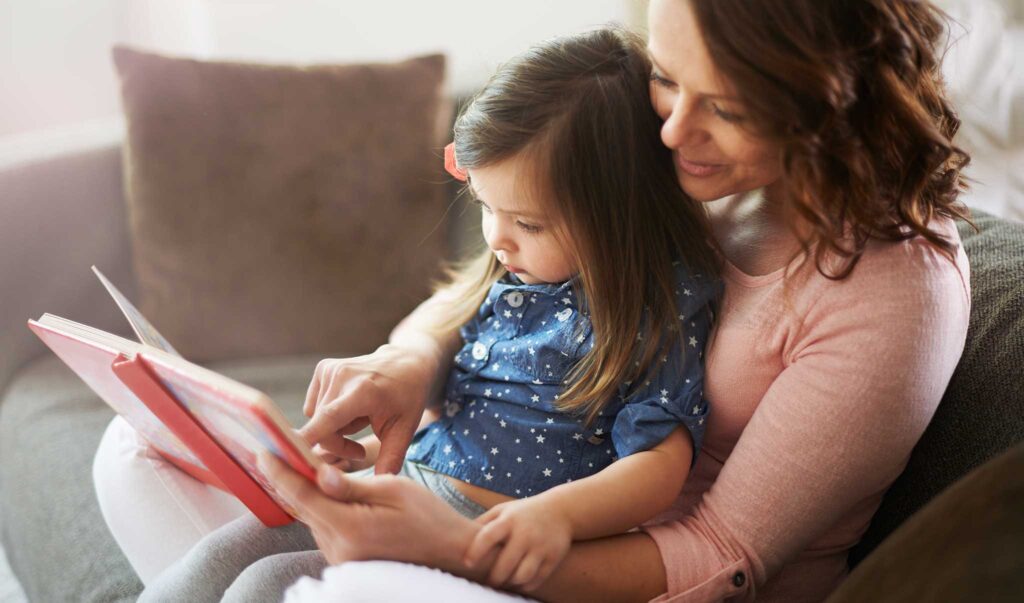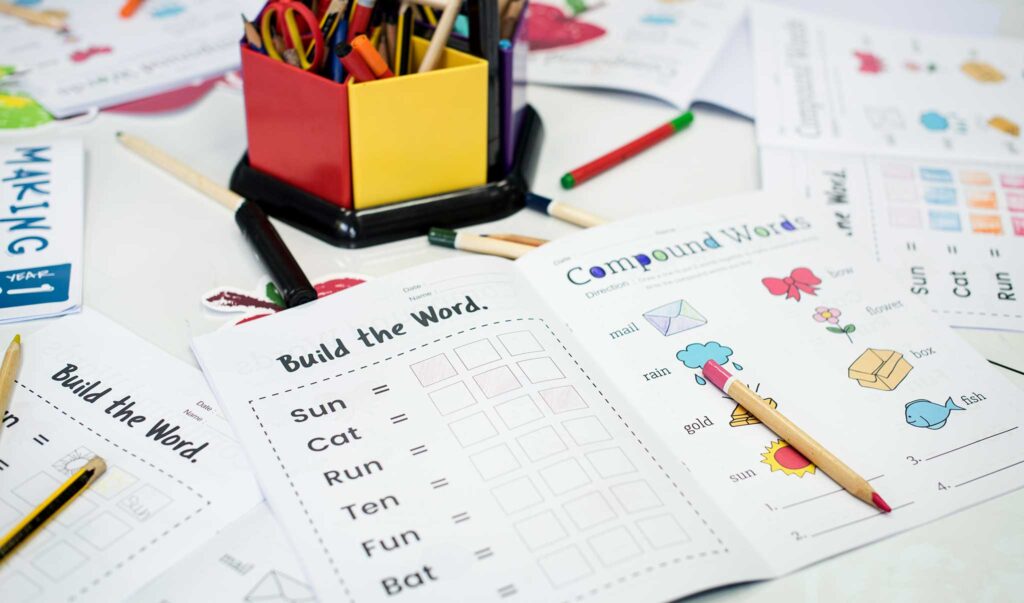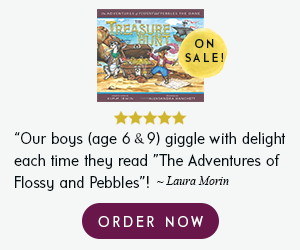
Reading to children is more important than you may know. Learn the research-backed benefits of reading to your child, what to read to your kids at different ages, and even more tips.
IN THIS ARTICLE:
9 Important Benefits of Reading to Children
I’ve long believed that reading to children is beneficial. I learned from my own experiences that it becomes a special bonding experience between parent and child. I’ve also suspected that it helps children develop their vocabulary and makes learning to read easier for them when that time comes.
When I began researching the subject, however, I discovered that the benefits of reading to your kids is much further-reaching. If you need some motivation to make story time a regular habit, read on to learn why it’s not only a good idea, but essential to your child’s development and well-being.
1. Reading Strengthens the Bond Between You and Your Child

A study out of Leiden University’s Center for Child and Family Studies in The Netherlands found that the relationship between mother and child was more secure the more frequently the mother read to the child.
Giving your children that undivided attention on a regular basis makes them feel special and builds their self-esteem. It shows them that they are important to you and that you enjoy spending time with them.
Additionally, when you read to your little ones about people, places, and things that are brand new to them, they begin to view you with awe and wonder. This helps them develop respect for you as an authority figure and helps establish healthy parent-child boundaries.
And, when you hold or cuddle your children while reading to them, the bonding effect intensifies. This is because the physical touch causes their brains (yours, too, for that matter) to release the so-called “love hormone” oxytocin. This hormone not only makes your children feel more bonded to you, it alleviates their stress and helps them deal with upset feelings that they haven’t yet learned to modulate.
2. Reading to Children Improves Their Cognitive Development

As defined on healthofchildren.com, cognitive development is “the construction of thought processes, including remembering, problem solving, and decision-making, from childhood through adolescence to adulthood.”
From infancy to early childhood and beyond, many studies have observed the cognitive benefits of reading aloud to your children:
University of Nebraska researchers found that infants who are read to everyday had higher cognitive scores than those who were read to infrequently or not at all.
A study conducted by the University of Melbourne found a direct causal link between children’s later reading and cognitive skills and how frequently they were read to prior to starting school.
And, as we’ll discuss more below, continuing to read to (and with) your children after they learn to read themselves affords them ongoing assistance with their cognitive development, not to mention many other advantages over kids whose parents no longer share reading with them.
3. Reading Expands Children’s Vocabulary

A study found that kids who are read 1 book a day will hear 290,000 more words by age 5 than those who are read to infrequently or not at all. And children who are read 5 books per day will hear a staggering 1.4 million more words than children who aren’t read to.
Words in books are often more complex than those we use in every day conversation, and they cover subject matter we don’t frequently discuss. So when you read to your children, you’re familiarizing them with thousands upon thousands of words they would otherwise not know.
And if you think your child will gain the same benefit from watching TV, think again: Children’s books contain 50% more rare words than TV, radio, or even college students’ conversations. (The Read-Aloud Handbook, by Jim Trelease)
4. Reading to Kids Teaches Them Empathy

An article in the Scientific American reports that researchers at The New School in New York City discovered greater empathy in those who read fiction than those who do not. Similarly, reading fictional stories to your children teaches them how to explore life from another’s perspective, to put themselves in someone else’s shoes.
Reading to your kids also teaches them to be attentive, patient listeners—an essential skill necessary for having meaningful interactions and developing caring relationships as they get older.
5. Reading Increases Children’s Creativity

One of my favorite aspects of reading a great book is the imagined adventures it takes me on. I love being whisked away to far off lands, becoming deeply acquainted with interesting characters, or even putting on my gumshoe hat to solve a good mystery.
While getting lost in imagination can be a great escape and stress-reliever, imagination also paves the way for discovery and innovation. Our world would be so much blander and lives so much more difficult had if not for the creativity and curiosity that has led to the inventions, medical and technical advances, and modern conveniences we often take for granted.
Given that reading to children helps boost their creativity and encourages them to use their imaginations, you just might be paving the way for your child to become the next Marie Curie or Steve Jobs in doing so!
6. Reading to Kids Improves Their Concentration

You may notice that your little one becomes antsy and is easily distracted during story time. However, as you continue to read on a regular basis, your child will learn to listen more attentively and sit still for longer and longer periods of time. “This helps with reading comprehension, stronger self-discipline, longer attention span and better memory retention—skills that will benefit children as they go to school,” says Dinah Castro, a bilingual family well-being educator.
7. Reading Expands Kids’ Horizons

As discussed earlier, reading to children dramatically increases the amount of words they are exposed to prior to starting school. But it also exposes them to a variety of people, places, ideas, and situations they wouldn’t otherwise encounter in their young little lives. This not only expands their understanding of the world around them, but teaches them how to respond when they have new experiences in real life.
8. Reading to Children Enhances Their Academic Performance

“The single most significant factor influencing a child’s early educational success is an introduction to books and being read to at home prior to beginning school.” ~ National Commission on Reading, 1985
Why? In part, because reading to your children improves their own ability to read when the time comes:
“Children who are read to at least three times a week by a family member are almost twice as likely to score in the top 25% in reading compared to children who are read to less than 3 times a week.” ~ Denton, Kristen and Gerry West, Children’s Reading and Mathematics Achievement in Kindergarten and First Grade (PDF file), U.S. Department of Education, NCES, Washington, DC, 2002.
And greater reading proficiency and comprehension has been linked to better performance in science and math, as well as other academic subjects.
Reading to children also teaches them that reading is fun, making it more likely that they will read for pleasure as they get older.
Christy Whitten and Sam L. Sullivan of Sam Houston State University, and Sandra Labby of Texas A&M University-Texarkana, found that students who read for pleasure received higher scores in English, science, history, and mathematics than students who did not.
Other studies have shown that kids who read for pleasure score higher on standardized tests in all subjects and achieve greater overall academic performance. So reading to your children (and teaching them that reading is fun) gives them a significant advantage when they start school, one they will carry with them all the way to graduation.
9. Reading to Children Fosters a Life-Long Love of Reading

The more you read to children, the more likely they will become readers for life. And that’s a positive thing, as the benefits of being an avid reader extend into adulthood: Reading has been shown to reduce stress-levels and blood pressure, and help you get more restful sleep.
Readers are typically better informed and have greater empathy than non-readers.
And, readers have stronger brains: According to an article in Psychology Today, “readers develop thicker cortexes (the part of your brain that handles higher order thinking), which provide extra cognitive reserves and better withstand neurological injuries and damage.”
Reading has even been shown to reduce memory loss, late-life cognitive decline, and lower the risk of dementia in older adults.
In summary, any one of these 9 benefits alone is reason enough to start reading to your child. But together, they prove that reading to children on a regular basis is essential to their emotional and intellectual growth and well-being.
How Soon Should I Start Reading to My Child?

Now that you know how important it is to read to your child, you may be wondering how soon you should start. The short answer is that it’s never to early to start. Read on to learn more about reading to your children at different stages of their development, as well as the best types of books to read to them at different age levels.
In the Womb
It’s a well established fact that babies in the womb begin to develop their hearing during the second trimester of pregnancy, though there is some discrepancy as to the specifics of the timing (The UK’s National Health Service (NHS) says 15 weeks, while this study observed first fetal reactions to sounds at around 19 weeks).
Even if you start reading a few weeks before your baby can actually hear you or react to your voice, the stress relief you experience as a result, not to mention the bond you are forging with your child, will make that time spent worthwhile.
The benefits of reading to your unborn child extend beyond the emotional, however: This study found that babies recall sounds and words they were exposed to in utero, and that they are better able to recognize speech patterns and acquire language after they’re born as a result.
What Should I Read to My Unborn Baby?
Earlier on, what you read to your baby-to-be isn’t as important as that you do it. Since your stress levels impact your baby’s well-being, and your enjoyment of the practice affects how often you’ll do it, choose material that you enjoy reading and that you find relaxing.
As you near the end of the 2nd trimester and baby’s hearing is becoming more developed, you may want to choose stories and poems that are repetitive, rhyming, or otherwise have a melodic quality to them, as your child will be able to detect those auditory fluctuations, even if unable to understand the words you are using.
There are dozens of books written specifically for parents to read to babies in utero. Here are a few to get you started:
- “The Wonderful Things You Will Be,” by Emily Winfield
- “Can’t Wait to Show You: A Celebration for Mothers-to-Be,” by Jacqueline Boyle
- “I Can’t Wait to Meet You!: Reading to Your Baby Before Your Baby is Born,” by Dr. Gary Benfield
Reading to Babies and Toddlers

If you started reading to your baby during your pregnancy, it makes sense to continue providing your child with those emotional, developmental, and intellectual benefits after birth. And if you haven’t started yet—well, there’s no better time than the present.
In the first few months of life, a child’s eyesight is still developing, so reading will be more about the bonding experience and the tone of your voice than the material itself. Soon you’ll notice your little one’s arms and legs moving to the rhythm of your speech—a precious milestone indeed!
During this stage, opt for books with large, vivid pictures and simple text that is rhyming or repetitive. “Welcome to the World” by Lucy Tapper is a sweet keepsake book that celebrates the arrival of your new baby.
Pamela High, MD, a professor of pediatrics at Brown University, also suggests reading books to your child that are interactive. Babies will love seeing their reflection in the mirrored pages of “Who Am I?: Mirror & Me,” by Scarlett Wing. And your little one will be infinitely entertained when you read from a finger puppet book such as this one.
As babies gets older, they will want to interact more and more with the books being read to them. The best options during this phase are board books, or those made of cloth or vinyl to ensure they can stand up to the wear and tear. For example, Amazon carries a collection of highly-rated soft books that were designed by a mom and art teacher.
Reading to Preschoolers

When children enter the preschool years, it is an ideal time to pave the way for their own love of reading. Frequently talk with your kids about how fun story time is, and how much you enjoy reading to them.
Readingrockets.org provides some excellent pointers on reading to preschoolers. One of the tips suggests building your child’s vocabulary by talking about some of the more intriguing elements you come across in your reading: “Look at that airplane! Those are the wings of the plane. Why do you think they are called wings?” is an example they provide.
Best Books for Preschoolers
When your child enters the preschool years, you will be able to replace the board, cloth, and vinyl books with “real” ones.
There are so many excellent books for preschoolers. You could opt for a classic like “Where the Wild Things Are” by Maurice Sendak, “Corduroy” by Don Freeman, or “Bread and Jam for Frances” by Russell Hoban—a personal favorite.
Or, you could select a newer release, like “The Adventures of Flossy and Pebbles the Dane: The Treasure Hunt.” 🙂
Reading to (and with) Older Children

If you think read aloud time ends when your children learn to read on their own, you’re not alone: Scholastic’s Kids and Family Reading Report states that while over 80% of both parents and children report loving reading time, the number of parents that read to kids drops dramatically once the children reach 5 years of age, and it continues to plummet for each year older children become.
But, evidence suggests that older children experience many of the same benefits as younger kids who are read aloud to, including a closer relationship with their parents, an expanded vocabulary, and a greater love for reading on their own.
It goes without saying that the reading material is going to change as your children get older. You can choose titles that are slightly above their reading level and take turns reading, which will stretch their vocabulary and reading skills. Taking turns will also keep you abreast of how your kids are progressing with their reading, and will alert you to any challenges they may be facing.
Tips for Reading to Your Children

If you don’t yet read to your children consistently and are wondering how and where to begin, these 5 tips will help you create a regular reading routine that both you and your kiddos will look forward to:
1. Start Early and Keep Going
As discussed above, it’s never too early to start reading aloud to your children. And continuing to do so well after they’ve started school will allow them to reap ongoing emotional, cognitive, and academic benefits.
So, no matter your child’s current age, just get started. You can work out the best time of day, frequency, and other details as you go along.
2. Make Reading Time a Habit, Not a Chore
Most experts recommend reading to your children daily (the MSU Extension suggests 30 minutes per day), but you have to do what works for your (probably hectic) schedule. It’s better to spend 10 minutes of quality reading time with your kids than force yourself (and them) to endure 30. That’s not going to be fun for anyone, and it will work against you in terms of instilling a love of reading in your children.
Experts also recommend picking a set time each day to read and adhering to that schedule. Again, do the best you can, and don’t stress if you have to move things around or even skip a day. The most important thing to keep in mind is that when you do read to your children, you want them to feel like it’s a positive experience—for everyone involved.
3. Have Some Fun With It!
Using different voices for different characters, making sound effects and even silly faces will not only help maintain your children’s attention and keep them entertained, it will help them better comprehend the material you’re reading to them.
It will also help keep things more interesting for you, especially when your little one insists on hearing The Little Engine That Could for the 427th time (see below). So, loosen up, get silly, and have some fun with it!
4. Patience, Patience, Patience!
When it comes to reading to your children, patience is definitely going to be needed, especially for that aforementioned 427th read-through of the same book. Kids learn through repetition—we all do, actually. So hearing the same book over and over again will help them commit the words you are speaking to memory.
Kids also ask a lot of questions, and that helps them learn, too. Most experts agree that it’s better to stop in the middle of the story to answer your children’s questions, rather than making them wait until you’re done reading.
5. Offer Plenty of Variety
The above advice on repetition notwithstanding, reading to your children about a wide variety of subjects will increase not only their vocabulary, but their understanding of the world around them as well. So choose books about different types of people, situations, objects, environments, etc. to help expand your little ones’ minds.
In Closing
In her earlier research, Jessica Logan, the author of one of the studies mentioned above, discovered that approximately 25% of children were never read to, and another 25% were only read to once or twice a week.
If your children fall into one of the above categories, there’s certainly no judgment here. You may be struggling to fit all of the “have-tos” into your busy day already, and the idea of adding even one more thing to the mix may feel overwhelming. Or, maybe you just didn’t realize how important reading to your kids really is.
Whatever your situation, I hope I’ve made the case for the importance of reading to your children. And I hope you will begin incorporating story time (when you can) into your family’s daily routine.
If you’re a parent or caregiver and you have some tips of your own for reading to children, please share them with us in the comments below.



Thanks for the tip about starting early. I’m hoping to try to read to my daughter every day. I’d really like to find some unique books for her to read.